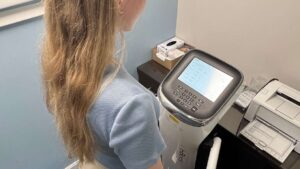
Reports from China have surfaced about a particularly severe sore throat associated with COVID-19 infections, colloquially termed as “razor blade throat.” This symptom has sparked concern among people in the United States, leading to a surge in online searches for terms like “new COVID variant painful symptom” and “COVID razor throat.”
Despite the alarming nickname, medical experts urge the public not to panic. Dr. William Schaffner, a professor of preventive medicine at Vanderbilt University Medical Center, explains that while the symptom may sound new, it is not unprecedented. “In the past, as new variants have emerged, there have been questions about distinctive symptoms. However, data often show that these symptoms have occurred before,” Schaffner noted.
Understanding the Symptom
The “razor blade throat” is described as an extremely painful sore throat, but it is not unique to the latest COVID-19 variants. Dr. Carrie Horn, chief medical officer at National Jewish Health in Colorado, emphasizes that a sore throat has been a common symptom of COVID-19 for some time. “It’s a symptom that has been associated with COVID infections for a while,” she said.
Dr. Mark Burns, an infectious disease expert at UofL Health, concurs, stating that while a sore throat can be severe, it is just one of many symptoms, which include fever, cough, and fatigue. “There is no increased intensity based on sore throat or anything like that,” Burns added.
Expert Opinions and Public Concerns
Both Schaffner and Horn stress that while the symptom can be uncomfortable, it is not indicative of a more severe infection. “The circulating COVID variants tend to produce the same sort of symptoms and disease as earlier ones,” Schaffner explained, noting that the recent Omicron variants are generally less severe.
“A sore throat is a symptom of this, but also fever and cough and fatigue, these are all symptoms as well.” — Dr. Mark Burns
Protective Measures and Recommendations
As COVID-19 tends to surge twice a year, in winter and mid-to-late summer, Schaffner advises that individuals at higher risk should consider two vaccinations annually. “One in the fall to prevent the winter increase, and another in the summer to help prevent serious disease during the late summer and early fall,” he said.
This recommendation is particularly pertinent for those over 65, individuals with chronic medical conditions, and pregnant people. “The recommendation is to take special precautions and get that extra dose,” Schaffner emphasized.
Additional protective measures include wearing masks indoors, practicing social distancing, frequent hand washing, and improving ventilation in enclosed spaces, according to Burns.
Managing Symptoms and Treatment Options
For those who do contract COVID-19, there are treatments available. Schaffner advises anyone with symptoms such as sore throat, fatigue, cough, or fever to take a COVID test and consult their doctor, especially if they are high-risk. “It’s important to talk to your primary care provider as guidance will vary depending on your age, underlying conditions, and other risk factors,” he said.
Horn recommends over-the-counter medications like Ibuprofen and Tylenol to alleviate symptoms and stresses the importance of staying hydrated. “A sore throat can make hydration feel like more of a chore, but it’s important to drink water and herbal teas,” she advised.
“If you are sick, it’s best to keep your germs to yourself. Preventing transmission is the biggest thing that we can do to help keep everybody healthy.” — Dr. Carrie Horn
In conclusion, while the “razor blade throat” may sound daunting, it is a known symptom of COVID-19 and not indicative of a new or more dangerous variant. By staying informed and taking recommended precautions, individuals can protect themselves and others from the virus.





